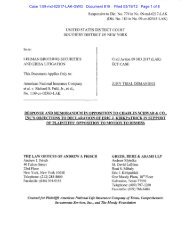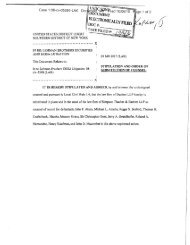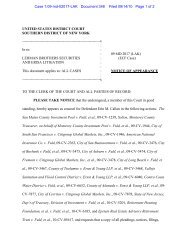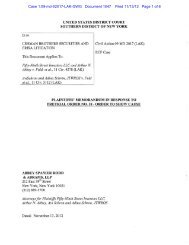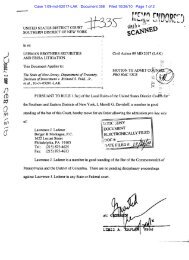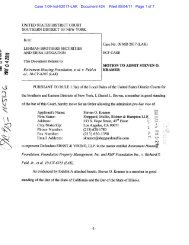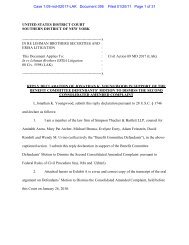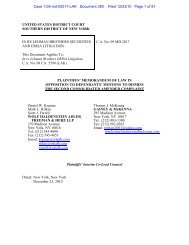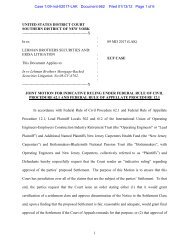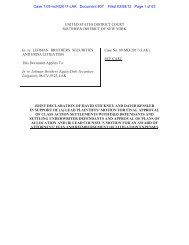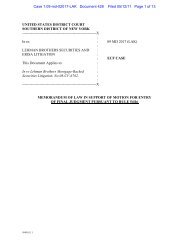Third Amended Complaint - Lehman Brothers Securities Litigation
Third Amended Complaint - Lehman Brothers Securities Litigation
Third Amended Complaint - Lehman Brothers Securities Litigation
Create successful ePaper yourself
Turn your PDF publications into a flip-book with our unique Google optimized e-Paper software.
76. Indeed, in order to engage in riskier transactions, <strong>Lehman</strong> raised its risk appetitelimit four times between December 2006 and December 2007, from $2.3 to $3.3 billion, then to$3.5 billion, then to $4.0 billion, and then regularly exceeded even these increased limits byhundreds of millions of dollars. Furthermore, between May and August 2007, <strong>Lehman</strong> excluded its$2.3 billion bridge equity position in Archstone (as well as other large bridge equity positions) fromits risk appetite usage calculations which, if included, would have caused <strong>Lehman</strong> to further exceedits risk limits. In May 2007, when <strong>Lehman</strong> committed to Archstone, “[i]t was clear,” according tothe Examiner, “that the Archstone transaction would put <strong>Lehman</strong> over its then existing risk limits,but the deal was committed anyway.” <strong>Lehman</strong> exceeded its risk appetite limit by $41 million inJuly 2007 and $62 million in August 2007, and after the Archstone and other bridge equity positionswere added, <strong>Lehman</strong> exceeded its risk appetite limits by $608 million in September 2007, $670million in October 2007, $508 million in November 2007, $562 million in December 2007, $708million in January 2008, and $578 million in February 2008. As the Examiner found, <strong>Lehman</strong>’sdisregard for this “hard” limit facilitated a dramatic expansion of the firm’s risk profile between2006 and 2007.77. <strong>Lehman</strong> also had “concentration limits,” which were designed to ensure that theCompany did not take too much risk in a single, undiversified business or area. However, <strong>Lehman</strong>routinely and consistently disregarded the concentration limits with respect to its leveraged loan andcommercial real estate business, including by failing to enforce the Company’s “single transactionlimits,” which were meant to ensure that its investments were properly limited and diversified bybusiness line and by counterparty. The single transaction limit was composed of two limits: (1) alimit applicable to the notional amount of the expected leveraged loan (i.e., the total value of aleveraged position’s assets); and (2) a limit applicable to the amount that <strong>Lehman</strong> was at risk oflosing on the leveraged loan. The Examiner testified that, in late 2006, <strong>Lehman</strong> decided “todisregard the single transaction limit.” By July 2007, <strong>Lehman</strong> had committed to approximately 30deals that exceeded its $250 million loss threshold, and five deals that violated the notional limit of-23-



